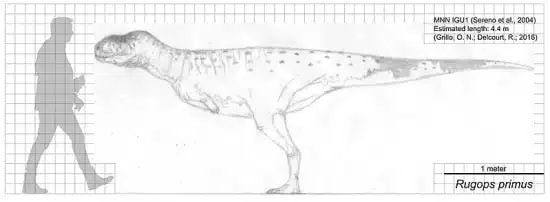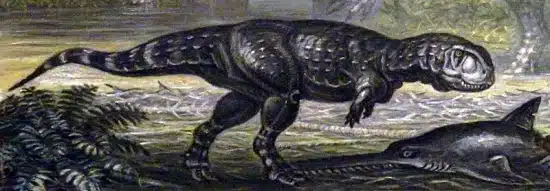Here, we explore the Rugops, a Theropod dinosaur from the Late Cretaceous Period that presents a fascinating subject for paleontological study. Discovered in Niger in the year 2000, this carnivorous dinosaur is notable for its distinctive features as suggested by its name, which translates to “wrinkle face.”
The discovery and subsequent description of Rugops by Paul Sereno and his team in 2004 have provided valuable insights into the evolution of the predatory dinosaurs that existed nearly a hundred million years ago.
Rugops Key Facts
| Keyword | Fact |
|---|---|
| Pronunciation | roo-gops |
| Meaning of name | Wrinkle face |
| Group | Theropod |
| Type Species | Rugops primus |
| Diet | Carnivore |
| When it Lived | 99.6 to 93.5 MYA |
| Period | Late Cretaceous |
| Epoch | Early/Lower Cenomanian |
| Length | 14.4 to 19.7 feet |
| Height | 4.9 feet |
| Weight | 900.0 to 1,650.0 lbs |
| Mobility | Moved on two legs |
| First Discovery | 2000 by Paul Sereno |
| Location of first find | Niger |
| First Described by | 2004 by Paul Sereno, Jeffery Wilson and Jack Conrad |
| Holotype | MNN IGU1 |
Rugops Origins, Taxonomy and Timeline
Rugops, aptly named ‘wrinkle face’, is a basal abelisaurid Theropod dinosaur that roamed the lands of what is now the Echkar Formation in Niger during the Late Cretaceous Period. Specifically, it lived in the Cenomanian Epoch around 95 million years ago. The genus is monospecific, meaning it includes only one species, Rugops primus. Our knowledge of this species is primarily based on a partial skull, which provides a window into its unique characteristics.

The genus name is derived from the Latin word “ruga” (wrinkle) and the Greek word “opsi” (face), while the specific name “primus” (first) in Latin underscores its status as one of the earliest abelisaurids with a textured skull.
In terms of taxonomy, Rugops falls within the Abelisauridae family, a group of Theropod dinosaurs known for their distinctive skull features. Abelisaurids were primarily carnivorous and are believed to have been apex predators in their ecosystems. As a basal member of this family, this dinosaur provides valuable insights into the early evolutionary stages of these formidable Theropods. Its classification as a basal abelisaurid indicates that it possesses some primitive features compared to its later relatives, making it a crucial piece in understanding the evolutionary history of this group.
Discovery & Fossil Evidence

The only known specimen of Rugops, the holotype MNN IGU1, is a partial skull that lacks portions of the palate and skull roof. This crucial find was unearthed during an expedition in 2000 led by Paul Sereno near In-Abangharit in the Niger Republic. The specimen was recovered from the Echkar Formation of the Tegama Group, dating back to the Cenomanian Epoch of the Late Cretaceous Period, approximately 96 million years ago. The Echkar Formation has been a treasure trove of fossils, yielding other specimens of dinosaurs as well as several crocodylomorphs.

The holotype of Rugops that was described in 2004 by Paul Sereno, Jeffery Wilson, and Jack Conrad may represent a subadult individual. This inference is based on its relatively small size, the lack of fusion between the nasals, and the presence of a fenestra between the prefrontal, frontal, postorbital, and lacrimal bones. Another abelisaurid bone, a partial maxilla, was discovered in nearby Morocco in 2005. It was initially thought to belong to Rugops, but cannot be assigned to any genus because of its fragmentary nature.
Rugops Size and Description
The partial skull of Rugops measures about 12.4 inches and reveals several distinctive features. The top of its skull bears pits indicative of overlapping scales and the front of the snout suggests armor-like skin. These characteristics not only contribute to its unique appearance but also hint at possible defensive adaptations.
In line with other Abelisaurids, Rugops’ skull exhibits a textured external surface, a U-shaped dental arcade, and a broad maxillary-jugal contact. The presence of a socket on the maxilla and subrectangular-shaped alveoli are also notable. The orbital brow, though not fully formed, and the slender proportions of many skull bones such as the relatively thin nasals and large skull fenestrae, further distinguish Rugops from its contemporaries.
Size and Weight of Type Species

Despite the fact that the fossil evidence is limited to primarily parts of the skull, paleontologists have estimated Rugops’ length to be between 14.4 to 19.7 feet and its weight around 900.0 lbs. These estimates are based on comparisons with related species and the known dimensions of the skull. However, it’s important to acknowledge that without more comprehensive fossil remains, these figures remain speculative and subject to revision as new discoveries are made.
Interesting Points about Rugops
- Its name, meaning “wrinkle face,” is derived from the Latin “ruga” and Greek “opsi.”
- It belonged to the Abelisaurid family, known for their distinctive skull features.
- This carnivore lived during the Early Cenomanian Epoch of the Late Cretaceous Period.
- Discovered in Niger in 2000, it offers a glimpse into Africa’s dinosaur fauna.
- The holotype, MNN IGU1, primarily consists of cranial fragments.
The Rugops in its Natural Habitat
Rugops thrived in a world vastly different from ours. The Late Cretaceous landscape it inhabited was marked by diverse climates and geography. As a carnivore, Rugops was likely an active predator or scavenger that navigated a world filled with various prey and competitors. Its bipedal locomotion suggests a lifestyle adapted for hunting or scavenging, while its social behavior remains a topic of speculation. Rugops’ role in shaping its ecosystem, directly or indirectly, adds another layer to the complex tapestry of Cretaceous life for African dinosaurs.
Contemporary Dinosaurs
In the sweltering, lush landscapes of ancient Africa, this medium-sized Theropod roamed with a sense of cautious curiosity.

Roughly the size of a modern Rhinoceros, this dinosaur often found itself in the shadow of the colossal Carcharodontosaurus, a predator that dwarfed it in both size and ferocity. Picture a tense encounter: Rugops scavenging on the fringes while the larger Carcharodontosaurus claimed the lion’s share of a kill. The dynamics between them were likely a mix of wary respect and innate understanding of their places in the food chain. While formidable, our dinosaur was no match for the sheer power of Carcharodontosaurus and thus, wisely kept a safe distance.
In this prehistoric theatre, Rugops also shared the stage with the large, herbivorous Ouranosaurus. These two might have had a less confrontational relationship, given their different dietary preferences. However, competition for resources like water and territory could have sparked some tension. Perhaps Rugops would have cautiously approached a water source, only to find a herd of Ouranosaurus already there. The size difference was notable, with Rugops being smaller, yet it was their coexistence that painted a vivid picture of this ancient ecosystem.
Lastly, the presence of Paralititan, another gigantic herbivore, added another layer to Rugops’ world. These massive creatures were like walking fortresses, yet they posed little threat. Our smaller Theropod might have scavenged what predators like Carcharodontosaurus left behind from these giants.
Frequently Asked Questions
It was discovered in 2000 in an expedition led by Paul Sereno.
Its name means “wrinkle face” due to the textured appearance of the skull.
It was a Theropod, specifically an Abelisaurid.
It was found in Niger.
It lived during the Late Cretaceous Period.
It was a carnivore.
Sources
The information in this article is based on various sources, drawing on scientific research, fossil evidence, and expert analysis. The aim is to provide a comprehensive and accurate overview of Rugops. However, please be aware that our understanding of dinosaurs and their world is constantly evolving as new discoveries are made.
Article last fact-checked: Joey Arboleda, 11-03-2023
Featured Image Credit: Liam Elward, CC BY-SA 4.0 https://creativecommons.org/licenses/by-sa/4.0, via Wikimedia Commons
